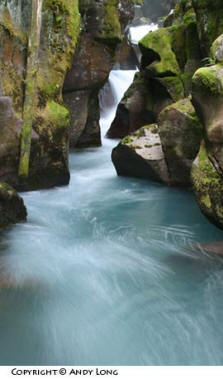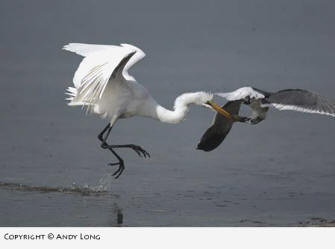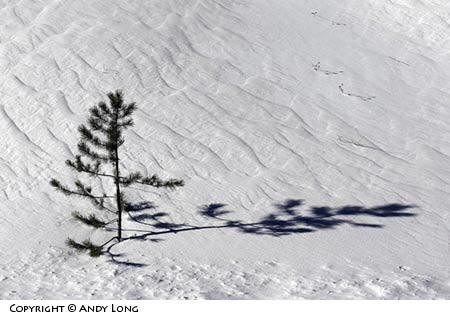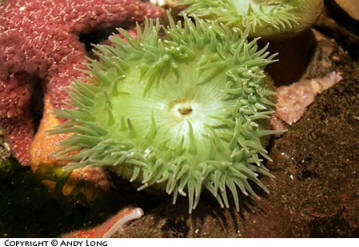Learn how to create great photos by tapping into what’s behind the camera – you!

You can almost feel the power of the glacial water cutting through the rocks.
Every story has two sides. You bring two people together who witnessed something happening, and you’ll probably hear two different takes on the events that occurred. Photography also has two sides. The first is the technical side that includes the settings on the camera and what was in the frame for the composition. The other side is a bit harder to explain–the part that comes from within the photographer.
When I write for online and print publications, I tend to describe great destinations I’ve visited or the technical aspects of taking a better picture in a particular situation. When I lead workshops, most participants go away muttering about how much more they have to learn because of the many aspects of photography I discuss at almost every turn. Selecting f-stops, bumping up the ISO, zooming in to isolate, compensating for exposure–the list goes on. When I’m asked how I can remember all the technical considerations that go into taking a good shot, I say that after more than 25 years of making money with a camera, remembering comes naturally.
It’s the other side of photography that doesn’t come as naturally, and I want to write about it, even though it comes naturally when I’m in the field taking pictures for myself. There are times when I go into autopilot. I can get away with being less aware in certain settings such as when I’m shooting wildlife and I’m trying to capture a specific behavior. However, even then, I try to “to become” and “to look.” While these goals are more difficult to write about, they’re as important as technical ability to taking great photographs.
Becoming
We’ve been provided with a beautiful place to live–magnificent creatures and landscapes all around. Every time I head out to photograph, I try to become part of the area where I am. (This happens more when I’m shooting on my own rather than when I’m with a workshop, even though I try to get people to relate to where they are and what they’re shooting.) Taking the time to become part of the area where you are allows you to soak it in and put more feeling into your work. You leave with better images. When light and line and form all come together, you can’t help but feel good about the area, and your emotion will show in the pictures you take. You’ve heard the expression “wonders never cease.” When you have an opportunity to go to take pictures of our beautiful country, you can live that saying each and every time you go out.

With wildlife. I look to see what type of behavior might occur in an area. My goal was to get the egret with a fish in it’s bill, but the gull coming to steal it made the moment even more special.
Looking
Take the time to look at what’s in front of you. The more you look, the more you see. You might not think there’s much there at first glance, but if you look more closely, you can find all sorts of subjects that can be photographed. Even if you don’t find a great picture, there’s beauty in what’s there. Every season has its own beauty that might not be present at another time of year.
Many times I’ve headed up to Rocky Mountain National Park for a morning of shooting but never touched the camera because either the wildlife didn’t cooperate or the lighting wasn’t right. And I’ve enjoyed these trips just as much as those when I took lots of images. Just being outside and the serenity of the isolation fill me with satisfaction.
The Inner Self
On the other side of photography, it’s vital to remember that what’s behind the camera is as important, or more important, than what’s in front of it. I started my writing and photography career doing sports where the main point of the photography was to use the technical aspects to capture several great action shots. When I first started doing nature photography, I used the same mentality, focusing on what was in front of the camera plus the technical side with f-stops, shutter speed, composition, capturing the behavior, and so on. Over time and with an ever-increasing acceptance of the beauty that was in front of me, the beauty became more important to my inner self. I wanted to capture my experience to share with others.

Winter is s great time to let yourself become part of the area and see what it means to the plant life.
When you begin in photography, the only person you have to please with your work is you. If the images you took on vacation remind you of a nice location or a fun event and you like them, then that’s all you can ask. As you improve your skills, you want others to like what they see when they look at your images. Indeed, they’ll like what they see if you really like what you see in your work. And you’ll like what you see a lot more if what’s in front of the camera inspires the person behind the camera. Putting the inspiration of knowing what you want to capture together with the technique to make it the best helps you create images with feeling–for both whoever views your work and you.
Take a look at the photos that you have hanging on the walls of your home. Are they just good technical images, or are they photos that were a combination of the technical side and the inspirational side? More than likely, they were the latter–images that have meaning to them, images in which you feel like you’re a part of the place.
In the past, I’ve written about creating mood with your photography. I have mood images hanging on my walls, including one by Ansel Adams of a tree silhouetted through the fog. In moody places, you can really get into the atmosphere of the surroundings–a foggy morning, a river or creek running over rocks, a picturesque cascade or waterfall, a beautiful field of flowers with magnificent peaks in the background, a snow-covered field. You can picture such settings in your mind and imagine the feeling you’ve had when you were in similar locations, taking the same shots.
Before I go to a location these days, I have in my mind images that I’d like to capture. A lot of times, I never see in front of me exactly what’s inside of me, but that’s fine. I can always adjust and let my inner self accept what’s there and use it to the best advantage. As I’ve gotten older and, hopefully, wiser, nature and landscape scenes are becoming more meaningful to my ever-growing collection of photos. I love capturing great wildlife action and always will, but being able to let myself breathe in the beauty of what’s out there releases a great picture from within me.

Walk around and look at all there is to a place before taking your first picture.

You can’t help but stand and look in amazement at the beauty of the aurora borealis as it dances across the sky.
by Andy Long

Leave a Reply